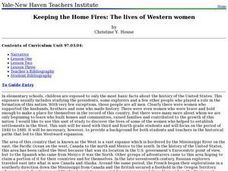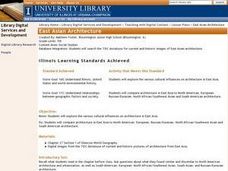Curated OER
Manifest Destiny and Westward Expansion
Students discover how manifest destiny and westward expansion are related. Using the Internet, they research the beginnings of the movement of manifest destiny and how it influenced people moving westward. They discuss the expectations...
Curated OER
The Battle for San Juan Hill: Santiago, Cuba, July 1, 1898
Eleventh graders design and create a poster, advertising for recruitment of volunteers to serve with Teddy Roosevelt in the 1st Volunteer Calvary Regiment. Students create a historical newspaper front page, from the time period, which...
Curated OER
Manifest Destiny
In this Westward Expansion worksheet, students read assigned textbook pages which describe Manifest Destiny and respond to 33 short answer questions.
Curated OER
End of the Line: What Happened to the Blue Ridge Railroad?
Sixth graders study the westward expansion and the role of railroad construction to the expansion. In this railroad history lesson, 6th graders complete KWL activity for the topic. Students view a PowerPoint about the growth of railroads...
Curated OER
The United States in 1790
In this geography skills worksheet, students study the provided map of the United States in 1790 and then complete the provided quiz over the 17 states and territories.
Curated OER
Keeping the Home Fires: The lives of Western women
Fourth graders explore the various trails that settlers took West from Missouri. They examine the reasons that people took these trails as well as the kind of people who made the journeys. They examine the Oregon, the Mormon, the Santa...
Curated OER
Country Locations
First graders read a story and locate where the countries in the story are located. In this traditions lesson, 1st graders explore food dishes from different countries and discuss where they are located. Students tell their favorite...
Curated OER
African Architecture
Seventh graders investigate cultural influences on architecture in Africa south of the Sahara. They compare the architecture to that in North America, Europe, Russia, and North Africa, Asia, and South America.
Curated OER
East Asian Architecture
Seventh graders compare architecture in East Asia to North American, European, Russian/Eurasian, North African/Southwest Asian and South American architecture. They search the internet for current and historic images of East Asian...
Curated OER
Southeast Asian Architecture
Seventh graders search online for current and historic images of Southeast Asian architecture. They compare architecture in Southeast Asia to North American, European, Russian/Eurasian, North African/Southwest Asian and South American...
Curated OER
North African and Southwest Asian Architecture
Seventh graders search online for current and historic images of North African and Southwest Asian architecture. They compare North African and Southwest Asian architecture to North American, European, Russian/Eurasian, and South...
Curated OER
Russian and Eurasian Architecture
Seventh graders search online for current and historic images of Russian and Eurasian architecture. They compare current Russian and Eurasian architecture to North American, European, and South American architecture.
Curated OER
European Architecture
Seventh graders search online for current and historic images of European architecture. They compare current European architecture to North American, and South American architecture.
Curated OER
Crisis in the Classroom: Little Rock & Boston
Students examine periods and instances of racial disharmony in the aftermath of segregation in the South, and de facto segregation in the North. They analyze causes of antagonism between racial groups and explore possible solutions.
Curated OER
Brown v. Board of Education of Topeka
Twelfth graders explore desegregation as it occurred at various stages in United States history. They specifically chronicle the role of South Carolina in the desegregation case of Brown v. Board of Education.
Curated OER
Forest Joe Lesson Plan: Outlaw or Hero?
Students become familiar with an American legend that is unfamiliar to many. Presented with the legend of Forest Joe, a runaway slave who, much like Robin Hood, stole from the rich to give to the poor, students draw comparisons and...
Curated OER
The Fugitive Slave Law and Migration
Students examine the Fugitive Slave Law as a motivating factor for slaves to emigrate outside the United States. After discussing the relationships between fugitive slaves and North American and Caribbean countries, they write essays...
Curated OER
Mixing Races in New Orleans
Students discuss the changes in the legal, social, and political status of African Americans and those of mixed ethnicity after reading the narrative, Haitian Immigration: Eighteenth and Nineteenth Centuries.
Curated OER
Lawson's Many Roles
Students examine the life of John Lawson and his many roles he took on during his life. Using their text, they discover the area in which he traveled and lived. They write an essay about his movements and identifying his contacts in...
Curated OER
Human Rights and Discrimination
Fifth graders create a KWL chart on discrimination and human rights. While reading different stories, they take notes on each character in the books. To end the lesson, they discuss the forms of discrimination today and how African...
Curated OER
What is Tet?
Seventh graders examine the conflict in Vietnam. For this American History lesson, 7th graders analyze various pictures on the conflict. Students discuss their findings and feelings about the conflict in Vietnam.
Curated OER
Relationships to Others
Learners investigate aspects of a historical map drawn about 1721 by a Native American for presentation to the British governor of South Carolina, and draw maps of the classroom.
Curated OER
Mapping an Encounter
Students recognize aspects of a historical map drawn around 1721 by a Native American for presentation to British governor of South Carolina, compare it to European map of the same period, and create map that shows relationships of...
Curated OER
Black Women in Delaware's History
Students study the number of slaves in the US in 1790 by state and answer questions. They imagine that they were an enslaved African American women and determine how their life changed when slavery ended.

























